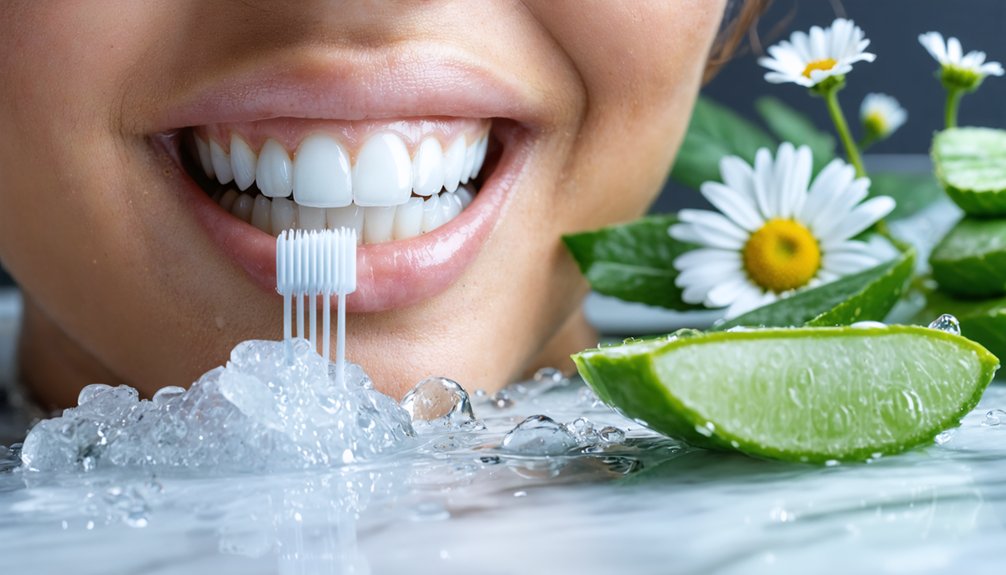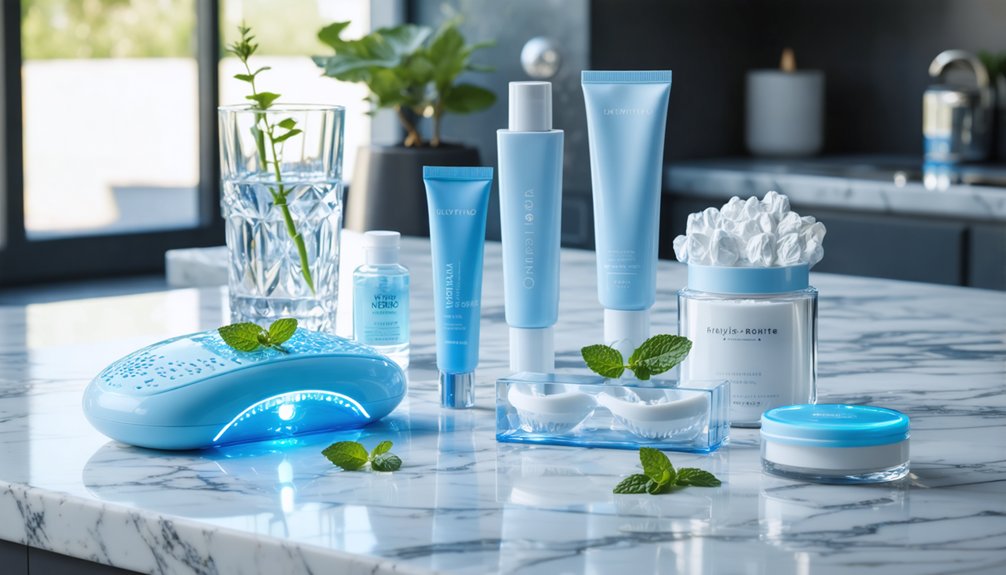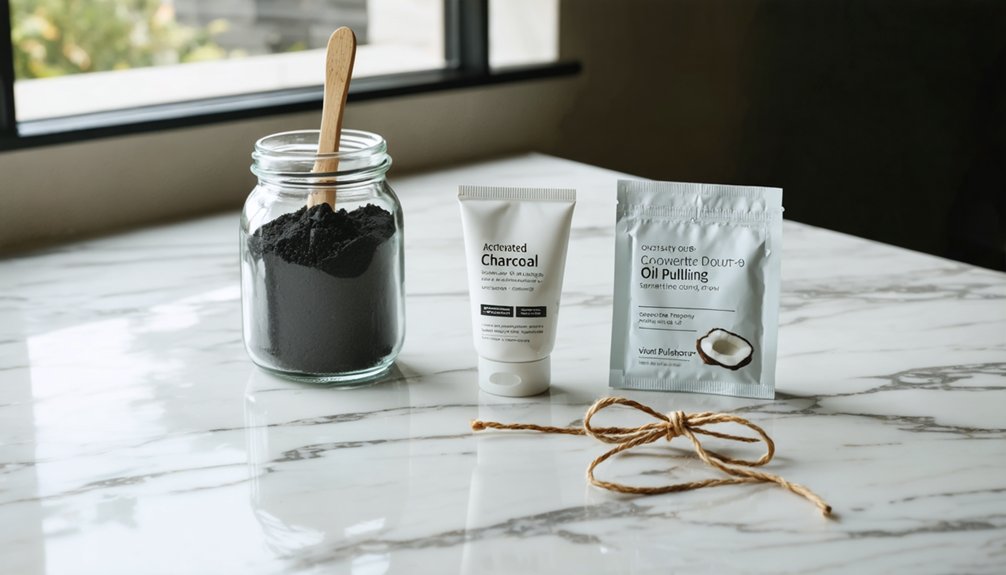For sensitive teeth, professional take-home whitening systems with custom-fitted trays offer the safest approach. You’ll want to start using desensitizing toothpaste containing potassium nitrate and fluoride two weeks before treatment. Custom trays guarantee even gel distribution while protecting your gums, and treatment times can be adjusted based on your sensitivity level. Working with your dentist allows for personalized protocols that minimize discomfort while achieving ideal results. Understanding additional protective measures can enhance your whitening success.
Key Takeaways
- Professional take-home tray systems with custom-fitted trays provide controlled whitening while minimizing sensitivity and ensuring even coverage of teeth.
- Use desensitizing toothpaste containing potassium nitrate and fluoride two weeks before starting any whitening treatment.
- Choose low-concentration peroxide products and gradually increase exposure time to minimize sensitivity while achieving desired results.
- Consider natural alternatives like oil pulling with coconut oil or baking soda paste for gentle whitening effects.
- Opt for LED devices with low-concentration gels, combined with consistent desensitizing treatments for safe, gradual whitening.
Understanding Tooth Sensitivity and Whitening
While tooth sensitivity affects up to 74% of adults globally, it’s particularly relevant when considering teeth whitening treatments. Your sensitivity occurs when exposed dentinal tubules transmit stimuli to nerve endings, causing sharp pain in response to temperature changes or chemical irritants.
Before believing whitening myths, you’ll need to understand that whitening agents can increase tooth sensitivity by making dentin tubules more permeable. If you’re already prone to sensitivity – which is more common in women and peaks between ages 38-47 – you’ll want to be especially cautious. With 98% showing dental erosion, it’s crucial to evaluate your enamel health before pursuing any whitening treatment. Regular spot checks during dental consultations can help identify sensitivity issues early.
Contributing factors like enamel erosion, gum recession, or bruxism can make your teeth more vulnerable to whitening-induced discomfort. Since about half of sensitivity sufferers don’t seek treatment, it’s essential to consult a dental professional before starting any whitening regimen.
Professional Take-Home Tray Systems
Although professional take-home tray systems require more upfront cost than over-the-counter options, they provide superior whitening results through custom-fitted trays and professional-grade gels. These systems are 84% more effective than typical over-the-counter whitening products. SportingSmiles offers FDA-approved gel that foams effectively into cracks and crevices.
Custom tray advantages include precise fit, minimized gum irritation, and better gel distribution to tooth irregularities. Your dentist will select appropriate whitening gel formulations based on your sensitivity level, typically using either carbamide or hydrogen peroxide with added desensitizing agents.
- Custom-fitted trays guarantee uniform coverage while protecting soft tissues
- Professional-grade gels offer balanced peroxide concentrations for optimal outcomes
- Treatment protocols can be modified based on your sensitivity levels
- Regular dental supervision helps maintain safety and effectiveness
You’ll achieve gradual whitening over 1-2 weeks, with the flexibility to perform touch-ups using your custom trays whenever needed.
Desensitizing Treatments Before Whitening
Because teeth whitening can trigger sensitivity in many patients, implementing proper desensitizing treatments beforehand is essential for comfort and success.
You’ll want to start using desensitizing toothpaste containing potassium nitrate and fluoride at least two weeks before your whitening procedure. These ingredients calm nerve endings and strengthen your enamel. Using a soft-bristled toothbrush during this preparation period helps prevent additional enamel wear.
Professional desensitizing techniques include applying specialized gels like GLUMA PowerGel directly to your teeth before treatment. These products effectively block dentin tubules and provide nerve protection during the whitening process.
Your dentist can also perform pre-treatment fluoride applications to fortify your enamel. Avoiding over-the-counter whitening products can prevent further enamel weakening and sensitivity issues. For best results, you’ll benefit from avoiding extreme temperature foods and beverages before your procedure.
These preventive measures greatly reduce discomfort while maintaining the effectiveness of your whitening treatment.
Gentle Over-the-Counter Options
When choosing over-the-counter whitening products for sensitive teeth, you’ll find that whitening strips generally provide more consistent results than pens due to their controlled application and measured peroxide concentrations.
You can safely begin with low-peroxide daily toothpastes, which offer gradual brightening while protecting sensitive nerve endings. Using a desensitizing toothpaste beforehand can help prepare your teeth for the whitening process. Most products will require 12 weeks of use before noticeable whitening results appear.
For ideal results, you’ll want to combine these gentler options with proper dental hygiene and careful adherence to product instructions to minimize potential discomfort.
Whitening Strips Vs Pens
Two popular gentle teeth whitening options – strips and pens – offer distinct advantages for different whitening needs.
When choosing between them, consider your whitening goals and sensitivity concerns. Both products help achieve radiant smiles without requiring dental visits. Strips provide broader coverage and more noticeable results, while pens excel at precision targeting and spot treatment. Pens offer quick-drying gel formulations that minimize waiting time during application.
- Whitening effectiveness varies greatly – strips typically deliver more dramatic overall results, whereas pens work better for surface stains and maintenance.
- Application convenience differs – pens offer quick, portable touch-ups, while strips require dedicated 15-30 minute sessions.
- Sensitivity risks can be lower with pens due to controlled peroxide concentrations and precise application.
- Treatment areas impact choice – choose strips for full-smile whitening or pens for specific problem spots.
Select your method based on your unique needs and comfort with application techniques.
Low-Peroxide Daily Toothpastes
Since sensitivity concerns often deter people from teeth whitening, low-peroxide daily toothpastes offer a gentler path to a brighter smile.
These formulations focus on low peroxide effectiveness through gradual whitening, removing surface stains while protecting your enamel with ingredients like potassium nitrate and stannous fluoride.
You’ll find brands like Sensodyne Extra Whitening and Crest 3D White Brilliance specifically designed for sensitive teeth.
These products work through mild chemical and abrasive actions rather than aggressive bleaching, providing 24-hour sensitivity relief while improving tooth brightness over time.
For enhanced enamel protection, look for toothpastes containing baking soda or PAP, which deliver whitening benefits without harsh peroxide exposure.
While results appear more slowly than professional treatments, you’ll experience fewer sensitivity issues and better long-term oral health.
Custom-Fitted Trays vs. One-Size Solutions
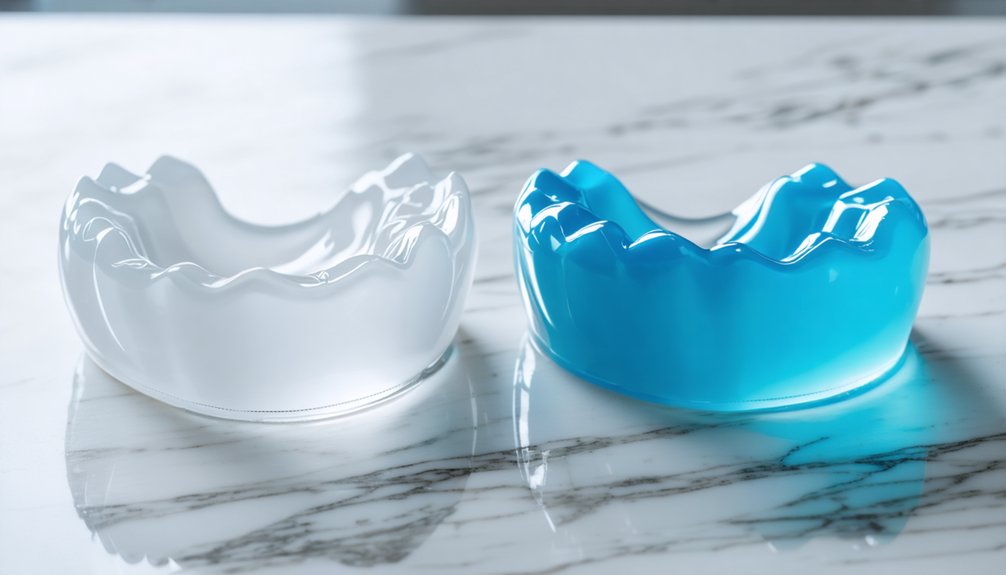
Choosing between custom-fitted whitening trays and one-size solutions can considerably impact your teeth whitening results.
Custom trays provide superior fit and safety through precise dental molds that guarantee even gel concentration distribution while minimizing gum irritation. You’ll experience more controlled and comfortable treatments with the ability to adjust gel concentration based on your sensitivity levels.
Custom-fitted whitening trays ensure precise gel application and enhanced comfort, letting you personalize treatment while protecting sensitive gums.
- Custom trays deliver professional-grade whitening with shorter wear times (15-30 minutes)
- Your treatment schedule remains flexible, allowing for brief sessions that fit your daily routine
- Precise fit prevents gel leakage and reduces sensitivity compared to generic alternatives
- You’ll achieve more consistent results across all tooth surfaces, including hard-to-reach areas
When serving patients with sensitivity concerns, custom trays offer the safest and most effective path to whiter teeth.
Protective Measures During Whitening
While pursuing a brighter smile, implementing protective measures during teeth whitening becomes essential for minimizing sensitivity and ensuring ideal results.
You’ll need to use custom-fitted trays with precise gel application to create effective protective barriers against gum irritation. Don’t oversaturate the trays with whitening gel, as this can lead to soft tissue inflammation.
Use a soft-bristled toothbrush during treatment and avoid brushing immediately after whitening sessions.
You’ll want to rinse with fluoride mouthwash to soothe your gums and strengthen enamel. When drinking beverages, use a straw to minimize contact with your newly whitened teeth.
Additionally, avoid extreme temperatures and acidic foods that could trigger sensitivity. For enhanced protection, apply desensitizing agents containing potassium nitrate and fluoride before and after your whitening sessions.
Natural Alternatives for Sensitive Teeth
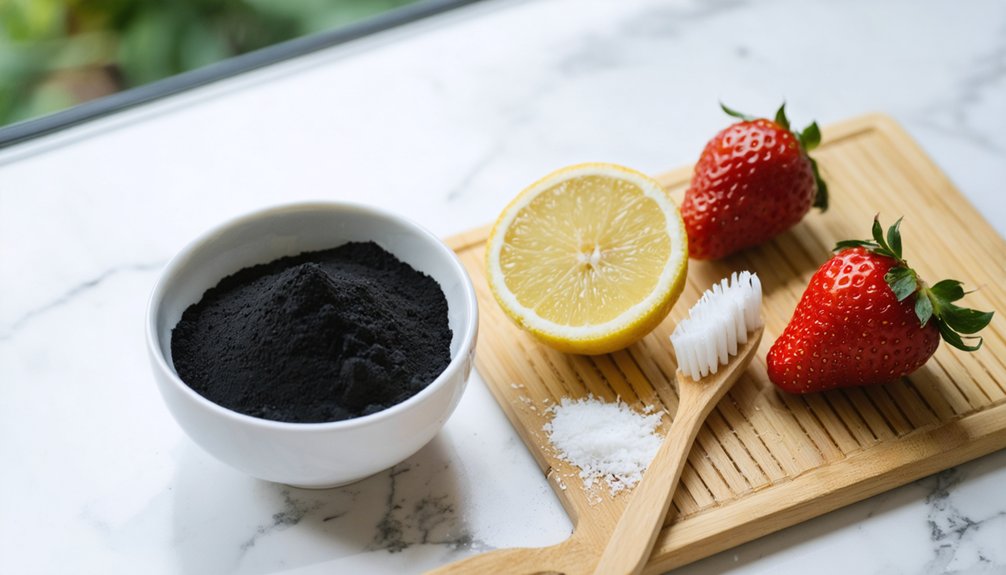
If you’re seeking gentle whitening solutions for sensitive teeth, several natural alternatives can help brighten your smile without causing discomfort.
You’ll find oil pulling with coconut oil and carefully diluted hydrogen peroxide treatments offer safer options than commercial whitening products, while high-fiber fruits and vegetables naturally clean teeth surfaces.
Combining these approaches with protective measures like calcium-rich foods and proper oral hygiene will support both whitening goals and long-term dental health.
Gentle Home Whitening Options
Several gentle whitening alternatives exist for people with sensitive teeth who want to avoid harsh chemical treatments.
You’ll find effective options that work gradually while protecting your enamel and minimizing discomfort.
- Create a gentle paste using baking soda benefits combined with 1% hydrogen peroxide for safe, controlled whitening that won’t aggravate sensitivity.
- Practice oil pulling effectiveness by swishing coconut oil daily for 15-20 minutes to reduce stain-causing bacteria naturally.
- Switch to hydroxyapatite toothpaste to form a protective barrier while whitening and reducing sensitivity.
- Use LED devices with low-concentration gels for gradual whitening that won’t harm sensitive teeth.
Choose these gentler methods to achieve whiter teeth without compromising your dental health or experiencing unnecessary pain from harsh treatments.
Natural Stain Prevention Tips
For those with sensitive teeth, preventing stains naturally requires a thoughtful combination of dietary choices and gentle cleaning methods.
You’ll find success through strategic dietary adjustments, such as incorporating crunchy fruits and vegetables that naturally scrub your teeth while eating. Foods like apples, carrots, and celery stimulate saliva production, which helps neutralize acids and wash away staining compounds.
Natural remedies like oil pulling with coconut oil and creating a gentle baking soda paste can effectively remove surface stains without harsh chemicals.
You’ll want to maintain consistent hydration throughout the day, as water helps rinse away potential staining agents. When consuming foods known to cause stains, such as coffee or berries, rinse your mouth immediately afterward to minimize discoloration risk.
These preventive measures protect your sensitive teeth while maintaining their natural brightness.
Maintaining Results Without Discomfort
While achieving a brighter smile is an important goal, maintaining those results without experiencing discomfort requires a strategic approach to oral care.
Getting a bright smile takes dedication, but the key to lasting results lies in mindfully protecting your teeth while pursuing whiteness.
You’ll need to balance whitening frequency with sensitivity management while making smart food choices that protect your investment in a brighter smile.
- Use fluoride-enhanced products and desensitizing toothpaste daily to strengthen your enamel and block pain signals that cause discomfort.
- Consume room-temperature foods and beverages, avoiding extremes that can trigger sensitivity.
- Drink acidic beverages through a straw to minimize contact with your teeth, and limit staining agents like coffee and red wine.
- Schedule periodic touch-ups using gentle whitening products specifically designed for sensitive teeth, rather than pursuing aggressive treatments that can cause lasting discomfort.
Signs to Stop or Modify Treatment
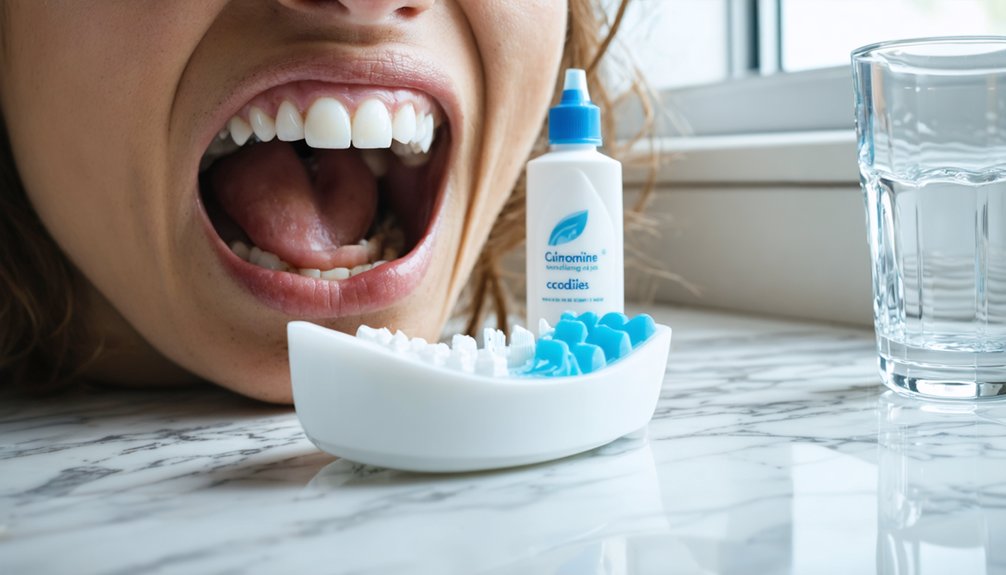
If you experience sharp, shooting pains or intense “zingers” during whitening treatment, you’ll need to stop immediately and contact your dentist.
You should also seek professional advice if sensitivity persists beyond 48 hours after treatment or interferes with eating and drinking.
Watch for signs of gum irritation, including bleeding or white spots on soft tissue, as these symptoms require prompt dental evaluation and possible modification of your whitening protocol.
Pain During Treatment
Understanding the signs of pain during teeth whitening treatment is essential for maintaining safety and preventing potential damage. You’ll need to monitor specific pain triggers and implement proper symptom management to guarantee a safe whitening experience.
- Pay attention to duration – mild sensitivity lasting 24-72 hours is normal, but pain persisting beyond a week requires immediate adjustment.
- Watch for intensity – sharp, throbbing pain that interferes with daily activities signals the need to stop treatment.
- Monitor temperature reactions – while temporary sensitivity to cold is common, severe reactions indicate potential nerve inflammation.
- Check gum response – any irritation or burning sensation in your gums means you should reduce contact with the bleaching agent.
If you experience severe discomfort, stop treatment and consult your dental professional for guidance on modifying your whitening approach.
When to Contact Dentist
Recognizing when to contact your dentist during teeth whitening treatment can prevent serious complications and guarantee excellent results. For ideal whitening safety, you’ll need to watch for persistent tooth sensitivity lasting more than a few days, gum irritation, or uneven coloring across your teeth.
Stop treatment immediately and seek professional guidance if you notice signs of enamel erosion, chemical burns on your gums, or unusual reactions to the whitening agents.
Your dentist can help with sensitivity management by adjusting treatment protocols or recommending specialized desensitizing products. Pay particular attention if you have existing dental work, as whitening agents can affect restorations differently than natural teeth.
You’ll also want professional evaluation if you experience increased sensitivity to hot and cold temperatures or notice any gum recession during treatment.
Long-Term Care for Whitened Sensitive Teeth
Once you’ve completed a teeth whitening treatment, maintaining proper long-term care becomes essential for sensitive teeth to prevent discomfort and protect your dental health.
For effective maintenance strategies and long-term sensitivity management, you’ll need to follow a thorough care routine.
- Schedule regular dental checkups every 3-6 months for professional monitoring of your enamel health and sensitivity levels.
- Use desensitizing toothpaste containing potassium nitrate or strontium chloride consistently, along with fluoride-containing mouthwash.
- Avoid acidic foods and beverages for at least 48 hours post-whitening, and stick to lukewarm drinks.
- Practice gentle brushing techniques and maintain consistent oral hygiene to prevent enamel damage and gum recession that can worsen sensitivity.
Your dentist can provide professional fluoride treatments to strengthen enamel and adjust your whitening schedule based on sensitivity levels.
Frequently Asked Questions
Can I Drink Coffee Immediately After Teeth Whitening Treatment?
You shouldn’t drink coffee immediately after teeth whitening. Wait at least 48-72 hours to prevent coffee staining, as your teeth’s enamel remains porous and vulnerable during this critical whitening timing window.
How Long Should I Wait Between Different Whitening Methods?
Like Rome wasn’t built in a day, you’ll need to wait 1-2 weeks between different whitening treatments. Don’t combine methods simultaneously, as proper whitening intervals protect your teeth from sensitivity.
Will Teeth Whitening Affect Existing Dental Work Like Crowns?
No, teeth whitening won’t change the color of your existing dental crowns since they’re made of non-porous materials. You’ll need to replace crowns if you want them to match your newly whitened teeth.
Does Teeth Sensitivity From Whitening Treatments Indicate Permanent Damage?
Your tingling teeth after whitening don’t signal permanent damage. Rather, it’s typically a temporary pulp inflammation that resolves within days to weeks as your teeth naturally recover their equilibrium.
Can Certain Medications Interfere With Teeth Whitening Effectiveness?
Yes, your medications can greatly impact whitening results. Many prescription drugs cause stains or dry mouth, while others create chemical interactions that reduce whitening effectiveness. Always inform your dentist about your medications.
References
- https://www.cincytoothdoc.com/teeth-whitening-for-sensitive-teeth-safe-options-that-work/
- https://www.blvddentistry.com/can-you-get-whitening-treatment-with-sensitive-teeth/
- https://www.sensodyne.com/en-us/oral-health-tips/whitening-sensitive-teeth/what-to-know/
- https://supremiadentistry.com/the-5-best-ways-to-whiten-sensitive-teeth/
- https://www.goodrx.com/conditions/dental-care/is-teeth-whitening-safe
- http://www.goochlanddentistry.com/whats-the-best-teeth-whitener-for-sensitive-teeth/
- https://pmc.ncbi.nlm.nih.gov/articles/PMC4058574/
- https://www.sandiegoartofdentistry.com/blog/what-is-the-best-teeth-whitening-method/
- https://pmc.ncbi.nlm.nih.gov/articles/PMC7448347/
- https://pmc.ncbi.nlm.nih.gov/articles/PMC11326452/
